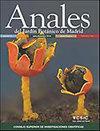Inflorescence and floral traits of the Colombian species of Tristerix (Loranthaceae) related to hummingbird pollination
IF 0.7
4区 生物学
Q4 PLANT SCIENCES
引用次数: 4
Abstract
Floral diversification in Loranthaceae reaches its highest peak in the Andes. The flowers of the exclusively Andean genus Tristerix exhibit tubular and vividly coloured flowers pollinated by hummingbirds. We studied inflorescence and flower morphoanatomy of the two Colombian species, T. longebracteatus and the highly endangered T. secundus . Both species have terminal racemes with up to 26 ebracteolate flowers, of which the proximal one opens and sets fruits first. The slightly irregular calyx initiation is followed by the simultaneous initiation of petals and the successive initiation of stamens. Anthesis is fenestrate, explosive, and triggered by the tension of the style against the abaxial petals, a mode so far not reported in Loranthaceae . Anthetic petals spread symmetrically in T. longebracteatus and asymmetrically in T. secundus . Nectar is produced by a supraovarial disk and by the petal mesophyll. Floral lifespan lasts up to 20 days. The hummingbirds Eriocnemis vestita and Pterophanes cyanopterus are the likely pollinators of T. secundus . Morphological traits are inconclusive to support one of the two competing sister group relationships that involve Tristerix , as the lack of cataphylls in renewal shoots links Ligaria and Tristerix , whereas the terminal inflorescences support its relationship with Desmaria and Tupeia .与蜂鸟传粉有关的哥伦比亚三棱属植物的花序和花性状
罗兰科植物的多样化在安第斯山脉达到最高峰。安第斯特有的三叶菊属的花呈管状,颜色鲜艳,由蜂鸟授粉。我们研究了哥伦比亚的两个种,T. longebracteatus和高度濒危的T. secundus的花序和花的形态解剖学。两种都有顶生总状花序,最多有26朵苞形花,其中近端的花首先开放和结果。稍微不规则的花萼萌发后,花瓣同时萌发,雄蕊相继萌发。花是开孔的,爆炸的,并且由花柱对背面花瓣的张力触发,一种模式到目前为止还没有报道在罗兰科。合生花瓣在长苞叶中对称展开,在次生叶中不对称展开。花蜜是由卵巢上圆盘和花瓣叶肉产生的。花的寿命可达20天。蜂鸟Eriocnemis vestita和Pterophanes cyanopterus可能是T. secundus的传粉者。形态学特征不确定是否支持两种姐妹类群关系中的一种,因为更新枝中缺乏葡萄梗将Ligaria和Tristerix联系起来,而顶生花序则支持其与Desmaria和Tupeia的关系。
本文章由计算机程序翻译,如有差异,请以英文原文为准。
求助全文
约1分钟内获得全文
求助全文
来源期刊

Anales Del Jardin Botanico De Madrid
PLANT SCIENCES-
CiteScore
1.20
自引率
0.00%
发文量
9
审稿时长
>12 weeks
期刊介绍:
Anales del Jardín Botánico de Madrid features original and unpublished articles in fields such as taxonomy and systematics of all plant groups and fungi, including related fields like biogeography, bioinformatics, conservation, ecophysiology, phylogeny, phylogeography, functional morphology, nomenclature and plant-animal relations, as well as reviews and summary works. Anales del Jardín Botánico de Madrid is published half-yearly, with two issues appearing in June and December.
 求助内容:
求助内容: 应助结果提醒方式:
应助结果提醒方式:


